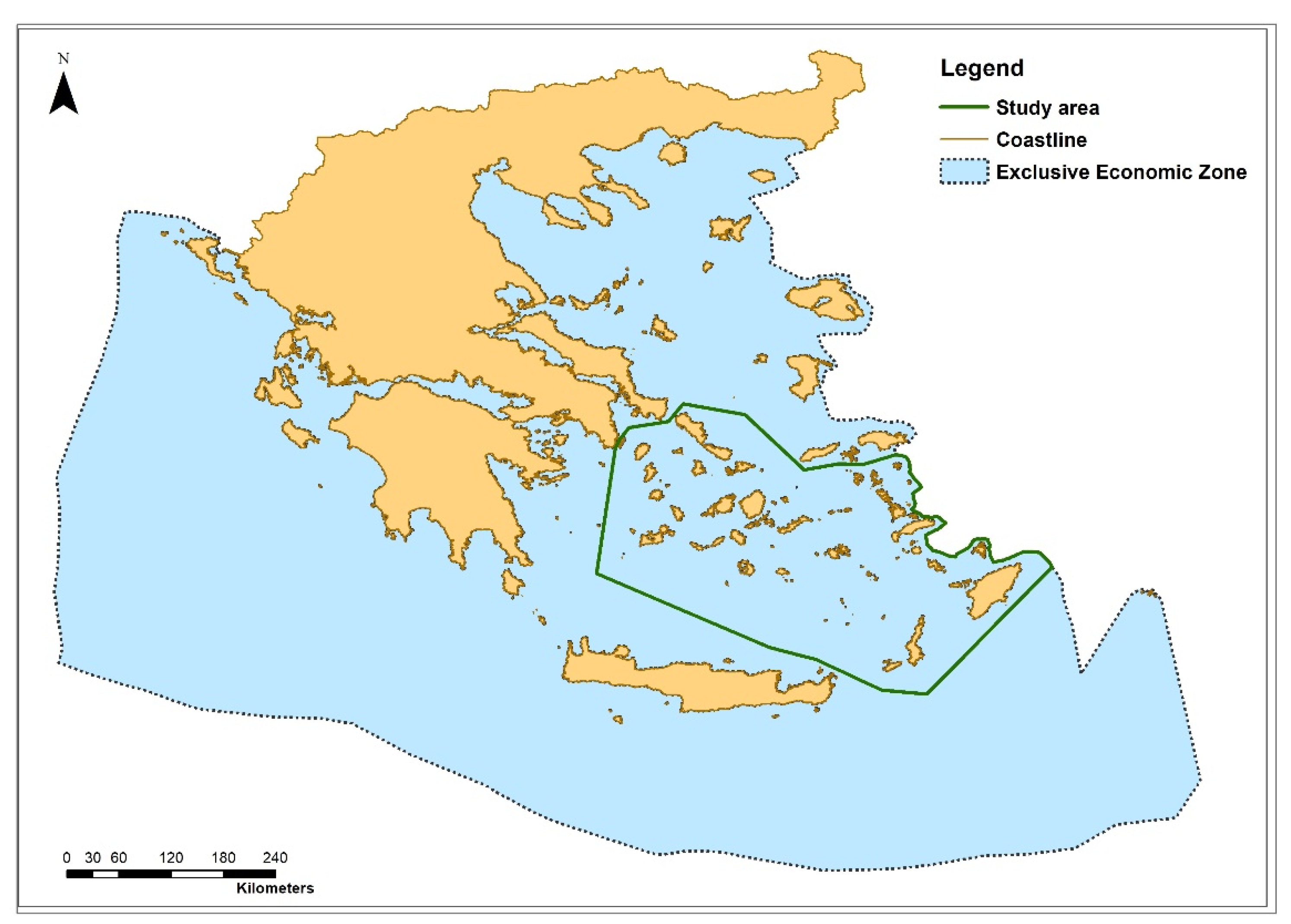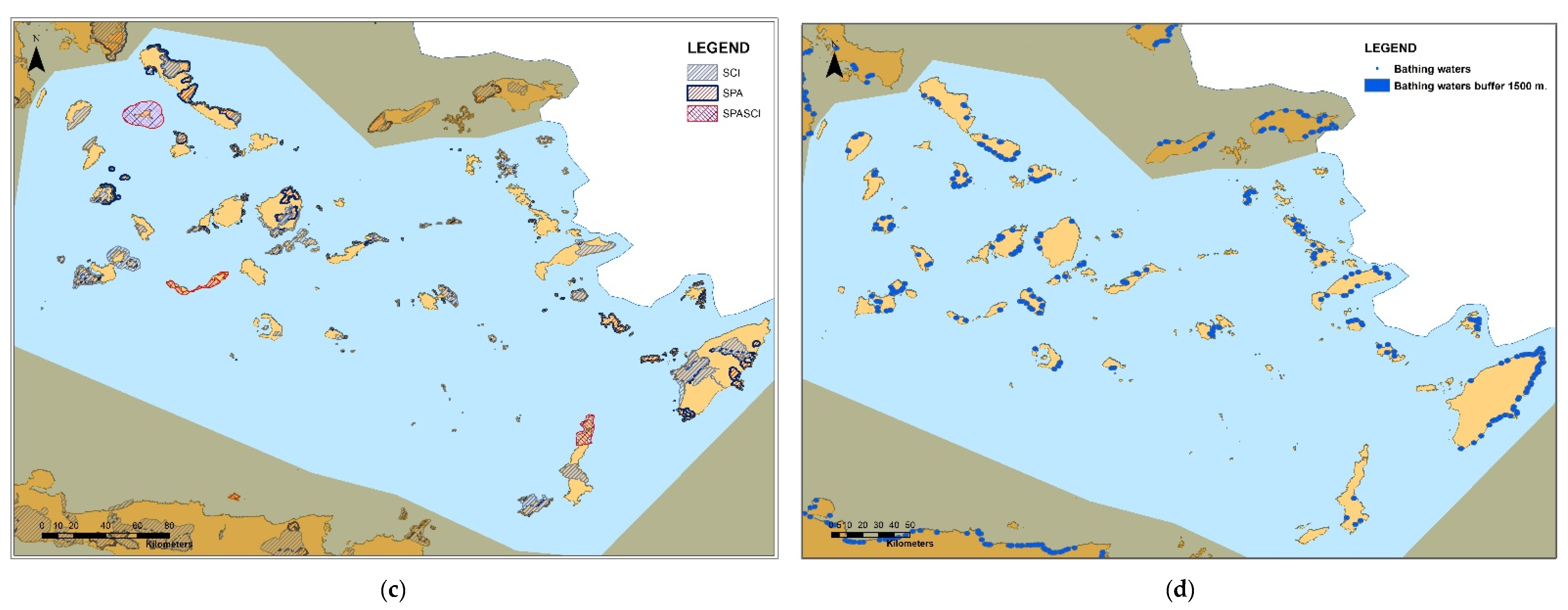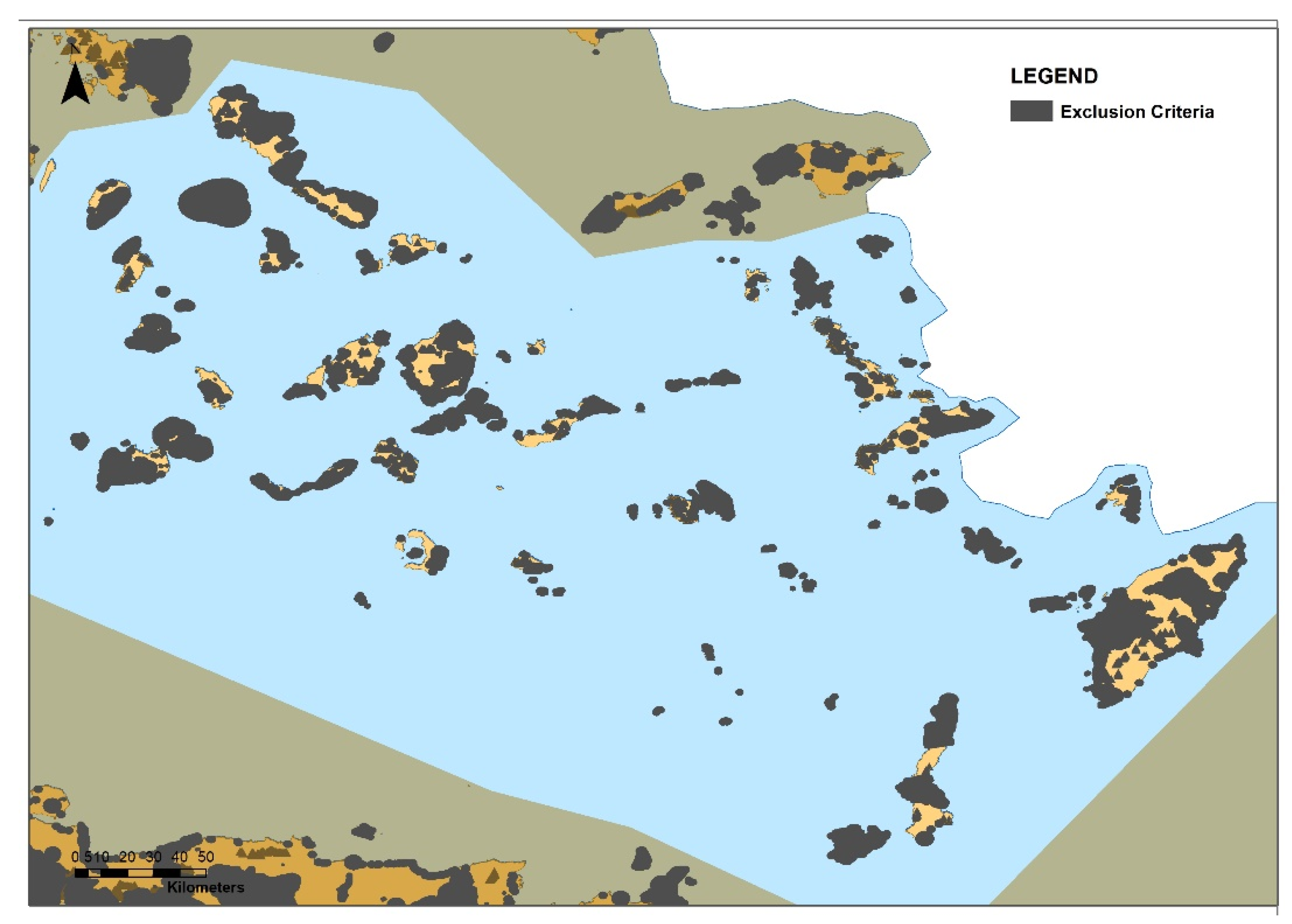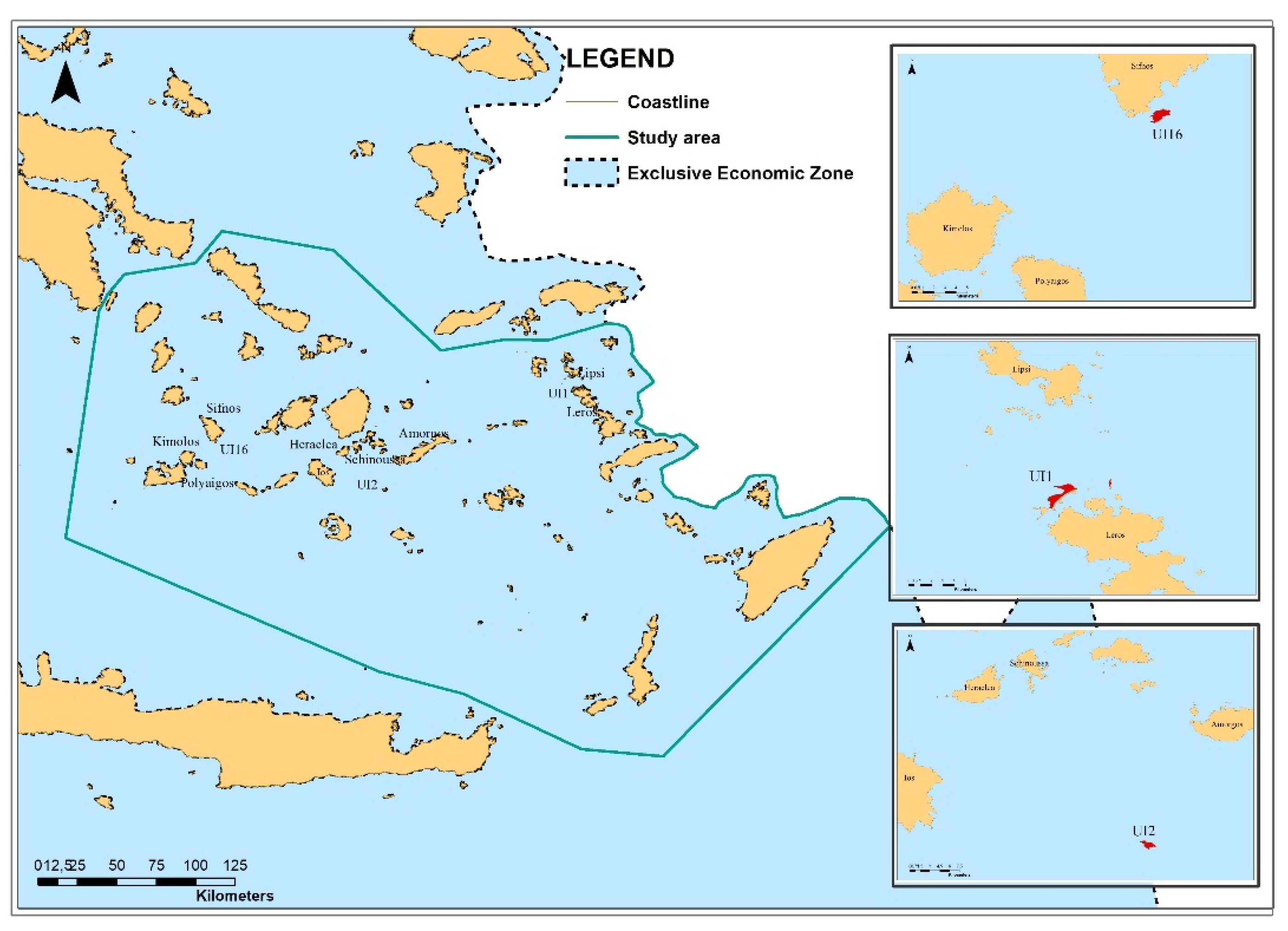Wind Farm Deployment in Uninhabited Islets: A Case Study the Region of the South Aegean (Greece)
Abstract
:1. Introduction
2. Materials and Methods
2.1. Study Area
2.2. Selection Criteria and Data Sources
2.2.1. Exclusion Criteria and Data Sources
2.2.2. Assessment Criteria
2.3. Multicriteria Decision Making
2.3.1. Analytical Hierarchy Process (AHP)
2.3.2. Technique for Order Preference by Similarity to Ideal Solution (TOPSIS)
3. Results and Discussion
3.1. Obtaining Feasible Sites
3.2. Weighting of the Assessment Criteria under Different Scenarios
3.3. Feasible Sites Prioritization
4. Conclusions
- Twenty (20) criteria (exclusion and assessment) were selected, based on the restrictions imposed by the national legal framework as well as onshore and offshore wind farm siting literature.
- The criterion of installation site area limitations (EC14) was crucial in the present study since it contributed to the exclusion of almost 89% of the eligible UIs.
- According to baseline scenario based on the authors’ expertise (Scenario 1) and the technical–economic-oriented policy scenario (Scenario 3), two technical/economic criteria (WV and SoT) represented the most important AC, while in the environmentally oriented policy scenario (Scenario 4), priority was given to environmental–economic criteria (SA, PS, and PEA).
- One primary limitation of using MCDM approaches in planning sites for energy generation is that they may lead decision makers to a subjective solution. However, our study surpassed the above restriction, since various and different policy scenarios were considered.
- The suitable UIs received the same ranking under the four different policy scenarios deployed (baseline, equal criterion weights, the policy scenario focusing on technical–economic considerations, and the environmentally oriented policy scenario), thus, contributing to the reliability of results.
- UI2 (Anydros near Amorgos) is the most preferable UI. This is mainly attributed to the simultaneous existence of the highest surface area, as well the ability of this location to serve a large population.
- The findings of the present study show the potential for installing wind farm projects in uninhabited islets and can be used to pinpoint particular locations in the South Aegean region. However, the implementation of such projects necessitates the development of a proper legislative framework related to the spatial planning of renewable energy projects.
Author Contributions
Funding
Institutional Review Board Statement
Informed Consent Statement
Data Availability Statement
Conflicts of Interest
References
- Latinopoulos, D.; Kechagia, K. A GIS-based multi-criteria evaluation for wind farm site selection. A regional scale application in Greece. Renew. Energy 2015, 78, 550–560. [Google Scholar] [CrossRef]
- Baseer, M.A.; Rehman, S.; Meyer, J.P.; Mahbub Alam, M. GIS-based site suitability analysis for wind farm development in Saudi Arabia. Energy 2017, 141, 1166–1176. [Google Scholar] [CrossRef] [Green Version]
- Bili, A.; Vagiona, D.G. Use of multicriteria analysis and GIS for selecting sites for onshore wind farms: The case of Andros Island (Greece). Eur. J. Environ. Sci. 2018, 8, 5–13. [Google Scholar] [CrossRef]
- Ayodele, T.R.; Ogunjuyigbe, A.S.O.; Odigie, O.; Munda, J.L. A multi-criteria GIS based model for wind farm site selection using interval type-2 fuzzy analytic hierarchy process: The case study of Nigeria. Appl. Energy 2018, 228, 1853–1869. [Google Scholar] [CrossRef]
- Höfer, T.; Sunak, Y.; Siddique, H.; Madlener, R. Wind farm siting using a spatial Analytic Hierarchy Process approach: A case study of the Städteregion Aachen. Appl. Energy 2016, 163, 222–243. [Google Scholar] [CrossRef]
- Ali, S.; Taweekun, J.; Techato, K.; Waewsak, J.; Gyawali, S. GIS based site suitability assessment for wind and solar farms in Songkhla, Thailand. Renew. Energy 2019, 132, 1360–1372. [Google Scholar] [CrossRef]
- Watson, J.J.W.; Hudson, M.D. Regional Scale wind farm and solar farm suitability assessment using GIS-assisted multi-criteria evaluation. Landsc. Urban Plan. 2015, 138, 20–31. [Google Scholar] [CrossRef]
- Sarpong, D.; Baffoe, P.E. Selecting Suitable Sites for Wind Energy Development in Ghana. Ghana Min. J. 2016, 16, 8–20. [Google Scholar]
- Villacreses, G.; Gaona, G.; Martínez-Gomez, J.; Juan Jijon, D. Wind farms suitability location using geographical information system (GIS), based on multi-criteria decision making (MCDM) methods: The case of continental Ecuador. Renew. Energy 2017, 109, 275–286. [Google Scholar] [CrossRef]
- Mahdy, M.; Bahaj, A.S. Multi criteria decision analysis for offshore wind energy potential in Egypt. Renew. Energy 2018, 118, 278–289. [Google Scholar] [CrossRef]
- Spyridonidou, S.; Vagiona, D.G.; Loukogeorgaki, E. Strategic Planning of Offshore Wind Farms in Greece. Sustainability 2020, 12, 905. [Google Scholar] [CrossRef] [Green Version]
- Vagiona, D.G.; Kamilakis, M. Sustainable site selection for offshore wind farms in the South Aegean-Greece. Sustainability 2018, 10, 749. [Google Scholar] [CrossRef] [Green Version]
- Christoforaki, M.; Tsoutsos, T. Sustainable siting of an offshore wind park a case in Chania, Crete. Renew. Energy 2017, 109, 624–633. [Google Scholar]
- Gavériaux, L.; Laverrière, G.; Wang, T.; Maslov, N.; Claramunt, C. GIS-based multi-criteria analysis for offshore wind turbine deployment in Hong Kong. Ann. GIS 2019, 25, 207–218. [Google Scholar] [CrossRef]
- Emeksiz, C.; Demirci, B. The determination of offshore wind energy potential of Turkey by using novelty hybrid site selection method. Sustain. Energy Technol. Assess. 2019, 36, 100562. [Google Scholar] [CrossRef]
- Vagiona, D.G.; Karanikolas, N.M. A multicriteria approach to evaluate offshore wind farms siting in Greece. Glob. NEST J. 2012, 14, 235–243. [Google Scholar]
- Spyridonidou, S.; Vagiona, D.G. Spatial energy planning of offshore wind farms in Greece using GIS and a hybrid MCDM methodological approach. Euro-Mediterr. J. Environ. Integr. 2020, 5, 24. [Google Scholar] [CrossRef]
- Schallenberg-Rodríguez, J.; Montesdeoca, N.G. Spatial planning to estimate the offshore wind energy potential in coastal regions and islands. Practical case: The Canary Islands. Energy 2018, 143, 91–103. [Google Scholar] [CrossRef]
- Tegou, L.-I.; Polatidis, H.; Haralambopoulos, D.A. Environmental management framework for wind farm siting: Methodology and case study. J. Environ. Manag. 2010, 91, 2134–2147. [Google Scholar] [CrossRef]
- Panagiotidou, M.; Xydis, G.; Koroneos, C. Environmental Siting Framework for Wind Farms: A Case Study in the Dodecanese Islands. Resources 2016, 5, 24. [Google Scholar] [CrossRef] [Green Version]
- Bertsiou, M.M.; Theochari, A.P.; Baltas, E. Multi-criteria analysis and Geographic Information Systems methods for wind turbine siting in a North Aegean island. Energy Sci. Eng. 2021, 9, 4–18. [Google Scholar] [CrossRef]
- Feloni, E.; Karandinaki, E. GIS-based MCDM Approach for Wind Farm Site Selection—A Case Study. J. Energy Power Technol. 2021, 3, 39. [Google Scholar] [CrossRef]
- Soares-Ramos, Ε.P.P.; de Oliveira-Assis, L.; Sarrias-Mena, R.; Fernández-Ramírez, L.M. Current status and future trends of offshore wind power in Europe. Energy 2020, 202, 117787. [Google Scholar] [CrossRef]
- IPCC. Climate Change 2007: Synthesis Report. Contribution of Working Groups I, II and III to the Fourth Assessment Report of the Intergovernmental Panel on Climate Change; Core Writing Team; Pachauri, R.K., Reisinger, A., Eds.; IPCC: Geneva, Switzerland, 2007; 104p. [Google Scholar]
- Hellenic Statistical Authority. Available online: http://www.statistics.gr/ (accessed on 29 January 2022).
- Ministry of Environment and Energy. Specific Framework for Spatial Planning and Sustainable Development for Renewable Energy Sources. Available online: https://ypen.gov.gr/wp-content/uploads/2020/11/FEK2464B_2008_RES.pdf (accessed on 17 January 2022).
- National Open Data Catalogue. Available online: www.geodata.gov.gr (accessed on 15 April 2022).
- Hellenic Navy Hydrographic Service. Available online: www.hnhs.gr (accessed on 15 April 2022).
- Mining and Quarrying Sites. Available online: www.latomet.gr (accessed on 15 April 2022).
- Greek Biotope/Wetland Centre. Available online: https://www.ekby.gr/ (accessed on 15 April 2022).
- Baban, S.M.J.; Parry, T. Developing and applying a GIS-assisted approach to locating wind farms in the UK. Renew. Energy 2001, 24, 59–71. [Google Scholar] [CrossRef]
- Ministry of Environment and Energy. Available online: www.ypen.gov.gr (accessed on 15 April 2022).
- Maps Portal of Geospatial Information. Available online: www.mapsportal.ypen.gr (accessed on 15 April 2022).
- Permanent List of Archaeological Sites and Monuments of Greece. Available online: www.listedmonuments.culture.gr (accessed on 15 April 2022).
- Tegou, L.I.; Polatidis, H.; Haralambopoulos, D.A. Distributed Generation with Renewable Energy Systems: The spatial dimension for an autonomous Grid. In Proceedings of the 47th Conference of the European Regional Science Association, Local Governance and Sustainable Development, Paris, France, 29 August–2 September 2007. [Google Scholar]
- Effat, H. Spatial Modeling of Optimum Zones for Wind Farms Using Remote Sensing and Geographic Information System, Application in the Red Sea, Egypt. J. Geogr. Inf. Syst. 2014, 6, 358–374. [Google Scholar] [CrossRef] [Green Version]
- Regularatory Authority for Energy. Available online: www.rae.gr (accessed on 15 April 2022).
- Van Haaren, R.; Fthenakis, V. GIS-based wind farm site selection using spatial multi-criteria analysis (SMCA): Evaluating the case for New York State. Renew. Sustain. Energy Rev. 2011, 15, 3332–3340. [Google Scholar] [CrossRef]
- Al-Yahyai, S.; Charabi, Y.; Gastli, A.; Al-Badi, A. Wind farm land suitability indexing using multi-criteria analysis. Renew. Energy 2012, 44, 80–87. [Google Scholar] [CrossRef]
- Gorsevski, P.V.; Cathcart, S.C.; Mirzaei, G.; Jamali, M.M.; Ye, X.; Gomezdelcampo, E. A group-based spatial decision support system for wind farm site selection in Northwest Ohio. Energy Policy 2013, 55, 374–385. [Google Scholar] [CrossRef]
- Anwarzai, M.A.; Nagasaka, K. Utility-scale implementable potential of wind and solar energies for Afghanistan using GIS multi-criteria decision analysis. Renew. Sustain. Energy Rev. 2017, 71, 150–160. [Google Scholar] [CrossRef]
- Saraswat, S.K.; Digalwar, A.K.; Yadav, S.S.; Kumar, G. MCDM and GIS based modelling technique for assessment of solar and wind farm locations in India. Renew. Energy 2021, 169, 865–884. [Google Scholar] [CrossRef]
- Kim, C.-K.; Jang, S.; Kim, T.Y. Site selection for offshore wind farms in the southwest coast of South Korea. Renew. Energy 2018, 120, 151–162. [Google Scholar] [CrossRef]
- Mekonnen, A.D.; Gorsevski, P.V. A web-based participatory GIS (PGIS) for offshore wind farm suitability within Lake Erie, Ohio. Renew. Sustain. Energy Rev. 2015, 41, 162–177. [Google Scholar] [CrossRef] [Green Version]
- Argin, M.; Yerci, V. The assessment of offshore wind power potential of Turkey. In Proceedings of the 9th International Conference on Electrical and Electronics Engineering (ELECO), Bursa, Turkey, 26–28 November 2015. [Google Scholar]
- Möller, B. Continuous spatial modelling to analyse planning and economic consequences of offshore wind energy. Energy Policy 2011, 39, 511–517. [Google Scholar] [CrossRef]
- Saleous, N.; Issa, S.; Al Mazrouei, J. GIS-based wind farm site selection model offshore Abu Dhabi Emirate, UAE. Int. Arch. Photogramm. Remote Sens. Spat. Inf. Sci. 2016, 41, 437–441. [Google Scholar] [CrossRef] [Green Version]
- Saaty, R.W. The analytic hierarchy process—What it is and how it is used. Math. Modell. 1987, 9, 161–176. [Google Scholar] [CrossRef] [Green Version]
- Saaty, T.L. How to make a decision: The analytic hierarchy process. Eur. J. Oper. Res. 1990, 48, 9–26. [Google Scholar] [CrossRef]
- Vasileiou, M.; Loukogeorgaki, E.; Vagiona, D.G. GIS-based multi-criteria decision analysis for site selection of hybrid offshore wind and wave energy systems in Greece. Renew. Sustain. Energy Rev. 2017, 73, 745–757. [Google Scholar] [CrossRef]
- Spyridonidou, S.; Vagiona, D.G. A comparative analysis of decision-making methods on site suitability for on-and offshore wind farms: The case of regional unit of Euboea, Greece. Circ. Econ. Sustain. 2021, 1–14. [Google Scholar] [CrossRef]
- Hwang, C.L.; Yoon, K. Methods for multiple attribute decision making. In Multiple Attribute Decision Making: Lecture Notes in Economics and Mathematical Systems, 1st ed.; Springer: Berlin/Heidelberg, Germany, 1981; Volume 186, pp. 58–191. [Google Scholar]
- Opricovic, S.; Tzeng, G.H. Compromise solution by MCDM methods: A comparative analysis of VIKOR and TOPSIS. Eur. J. Oper. Res. 2004, 156, 445–455. [Google Scholar] [CrossRef]
- ArcGIS. GIS Software, version 10.4.1; Environmental Systems Research Institute, Inc.: Redlands, CA, USA, 2018.
- Sliz-Szkliniarz, B.; Vogt, J. GIS-based approach for the evaluation of wind energy potential: A case study for the Kujawsko–Pomorskie Voivodeship. Renew. Sustain. Energy Rev. 2011, 15, 1696–1707. [Google Scholar] [CrossRef]
- Siyal, S.; Mörtberg, U.; Mentis, D.; Welsch, M.; Babelon, I.; Howells, M. Wind energy assessment considering geographic and environmental restrictions in Sweden: A GIS-based approach. Energy 2015, 83, 447–461. [Google Scholar] [CrossRef]
- Aydin, N.; Kentel, E.; Duzgun, S. GIS-based environmental assessment of wind energy systems for spatial planning: A case study from Western Turkey. Renew. Sustain. Energy Rev. 2010, 14, 364–373. [Google Scholar] [CrossRef]







| Exclusion Criteria | Unsuitable Areas | Literature ReviewSources | Data Sources | |
|---|---|---|---|---|
| Definition | Population (EC1). | >0 inhabitants | - | [27] |
| Safety | Military exercise areas (EC2). | <2500–3000 m | [17] | [28] |
| Mines and Quarries (EC3). | <500 m | [26] | [29] | |
| Airports (EC4). | <30,000 m <2500 m | [1,3] | [27] | |
| Protected areas | Areas of absolute nature protection and nature protection (EC5). | All <1000 m | [1,17,26] | [30] |
| Natura 2000 (EC6). | All <1000 m | [1,3,26,31] | [27] | |
| National parks, Natural monuments, and aesthetic forests (EC7). | All <1000 m | [26,31] | [27] | |
| Bathing waters (EC8). | All<1500 m | [17,26] | [32] | |
| Technical | Slope of the terrain (EC9). | >25% >10% | [1,17] | [33] |
| Cultural environment | Archaeological monuments, historical places of high importance (EC10). | 3000 m | [3] | [34] |
| Other | Cultural monuments and historical sites (EC11). | 1000 m | [3,31,35,36] | [34] |
| Existing wind farms under operation (EC12). | All | [37] | ||
| Wind farms with withdrawn decisions (EC13). | All | [37] | ||
| Installation site area limitations (EC14). | >0.90 km2 |
| Id | Description | Factor |
|---|---|---|
| AC1 | Wind velocity (WV) | Economic/technical |
| AC2 | Slope of the terrain (SoT) | Economic/technical |
| AC3 | Surface area (SA) | Economic/environmental |
| AC4 | Population served (PS) | Economic/environmental |
| AC5 | Protected environmental areas (PEA) | Environmental |
| AC6 | Proximity to potential islands served (PPIS) | Economic/technical |
| No. | Name | Area (km2) | No. | Name | Area (km2) |
|---|---|---|---|---|---|
| UI1 | Archangelos Leros | 1.280 | UI15 | Glaronisi 3 | 0.003 |
| UI2 | Anydros Amorgos | 1.138 | UI16 | Kitriani Sifnos | 0.940 |
| UI3 | Nata Syros | 0.017 | UI17 | Praso (Prasonisia) | 0.057 |
| UI4 | Plati Andros | 0.003 | UI18 | Sfontili (Prasonisia) | 0.006 |
| UI5 | Ftena Anafis 2 | 0.064 | UI19 | Kromidi (Prasonisia) | 0.017 |
| UI6 | Ftena Anafis 1 | 0.033 | UI20 | Kavouras Mykonou | 0.003 |
| UI7 | Tripiti Leros | 0.072 | UI21 | Baos Mykonos | 0.076 |
| UI8 | Xioliomodi Patmos | 0.275 | UI22 | Marmaronisi Mykonos | 0.019 |
| UI9 | Sklava Patmos | 0.015 | UI23 | Skilonisi Donousa | 0.250 |
| UI10 | Despotiko Karpathos | 0.004 | UI24 | Strogilo/Strogili (Makares Donousa) | 0.353 |
| UI11 | Diakoftis Karpathos | 0.038 | UI25 | Prasoura | 0.145 |
| UI12 | Nisieros Karpathos | 0.005 | UI26 | Galiatsos Paros | 0.009 |
| UI13 | Glaronisi 1 | 0.028 | UI27 | Makri Rhodes | 0.580 |
| UI14 | Glaronisi 2 | 0.003 |
| AC1 (WV) | AC2 (SoT) | AC3 (SA) | AC4 (PS) | AC5 (PEA) | AC6 (PPIS) | |
|---|---|---|---|---|---|---|
| AC1 (WV) | 1 | 3 | 3 | 5 | 7 | 9 |
| AC2 (SoT) | 1/3 | 1 | 3 | 3 | 5 | 7 |
| AC3 (SA) | 1/3 | 1/3 | 1 | 3 | 3 | 5 |
| AC4 (PS) | 1/5 | 1/3 | 1/3 | 1 | 3 | 5 |
| AC5 (PEA) | 1/7 | 1/5 | 1/3 | 1/3 | 1 | 3 |
| AC6 (PPIS) | 1/9 | 1/7 | 1/5 | 1/5 | 1/3 | 1 |
| AC1 (WV) | AC2 (SoT) | AC3 (SA) | AC4 (PS) | AC5 (PEA) | AC6 (PPIS) | Criteria Weights | |
|---|---|---|---|---|---|---|---|
| AC1 (WV) | 0.472 | 0.599 | 0.381 | 0.399 | 0.362 | 0.300 | 0.419 |
| AC2 (SoT) | 0.157 | 0.200 | 0.381 | 0.239 | 0.259 | 0.233 | 0.245 |
| AC3 (SA) | 0.157 | 0.067 | 0.127 | 0.239 | 0.155 | 0.167 | 0.152 |
| AC4 (PS) | 0.094 | 0.067 | 0.042 | 0.080 | 0.155 | 0.167 | 0.101 |
| AC5 (PEA) | 0.067 | 0.040 | 0.042 | 0.027 | 0.052 | 0.100 | 0.055 |
| AC6 (PPIS) | 0.052 | 0.029 | 0.025 | 0.016 | 0.017 | 0.033 | 0.029 |
| Scenario 1 | Scenario 2 | |||||
| UI1 | 0.141 | 0.078 | 0.356 | 0.165 | 0.125 | 0.431 |
| UI2 | 0.074 | 0.273 | 0.787 | 0.115 | 0.400 | 0.777 |
| UI16 | 0.170 | 0.072 | 0.296 | 0.186 | 0.106 | 0.363 |
| Scenario 3 | Scenario 4 | |||||
| UI1 | 0.102 | 0.150 | 0.595 | 0.261 | 0.150 | 0.365 |
| UI2 | 0.153 | 0.250 | 0.620 | 0.122 | 0.512 | 0.808 |
| UI16 | 0.119 | 0.138 | 0.537 | 0.292 | 0.095 | 0.245 |
Publisher’s Note: MDPI stays neutral with regard to jurisdictional claims in published maps and institutional affiliations. |
© 2022 by the authors. Licensee MDPI, Basel, Switzerland. This article is an open access article distributed under the terms and conditions of the Creative Commons Attribution (CC BY) license (https://creativecommons.org/licenses/by/4.0/).
Share and Cite
Vagiona, D.G.; Alexiou, V. Wind Farm Deployment in Uninhabited Islets: A Case Study the Region of the South Aegean (Greece). Wind 2022, 2, 451-465. https://doi.org/10.3390/wind2030024
Vagiona DG, Alexiou V. Wind Farm Deployment in Uninhabited Islets: A Case Study the Region of the South Aegean (Greece). Wind. 2022; 2(3):451-465. https://doi.org/10.3390/wind2030024
Chicago/Turabian StyleVagiona, Dimitra G., and Vasiliki Alexiou. 2022. "Wind Farm Deployment in Uninhabited Islets: A Case Study the Region of the South Aegean (Greece)" Wind 2, no. 3: 451-465. https://doi.org/10.3390/wind2030024
APA StyleVagiona, D. G., & Alexiou, V. (2022). Wind Farm Deployment in Uninhabited Islets: A Case Study the Region of the South Aegean (Greece). Wind, 2(3), 451-465. https://doi.org/10.3390/wind2030024







